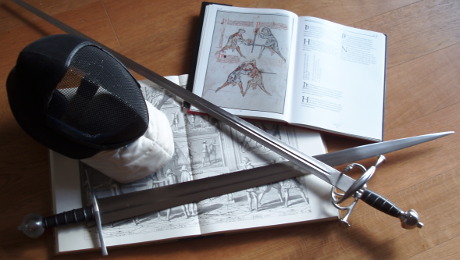
I will write quite a lot about HEMA in these pages. What is it? It stands for Historical European Martial Arts. Let us detail part after part, bearing in mind that these definitions are my personal opinions.
- Martial Arts
- A martial art is the combination of theoretical principles and sportive exercises, learned in order to better deal with violent confrontation. By violent confrontation, I mean a situation where physical integrity or life is threatened, i.e. something you cannot train for by just doing it often because of the risks involved.
- Historical
- This means that instead of learning from living exponents of the martial arts, studies are based on historical sources. Practical experience is used to better understand said sources. In a way, sources replace the living master in a traditional master-student relationship. Some people consider that archaeological sources (i.e. only artifacts and non-technical depictions) are not enough, but for some periods that is all we have. The ideal case is a written and illustrated record left by a master, and that is what most HEMA people base their work on.
- European
- This is actually the least important part in my opinion. The historical sources come from a European cultural background. Historical Martial Arts are especially meaningful in the European culture because most of the martial arts disappeared, being driven into practical irrelevance by technological and societal advances.
You will note that the focus of the study is loosely defined here. For most people it is primarily about sword arts, but there is a wide variety of sources for various times in history. It ranges from Viking sword & shield to 20th century bayonet instruction…
I will probably detail these in future posts, but several important observations can be made about that definition.
Firstly, martial arts are not just combat sports. Combat sports are good training and an integral part of many martial arts, but because martial arts are made to deal with a fundamentally different very unsafe situation, they ordinarily include other aspects. In the case of sword arts, a combat sport will focus study on the safe, blunt weapon, and a martial art will use this same weapon and also study the actual sharp sword. Most of our sources deal with martial arts, not just combat sport, and that should be reflected in the modern practice in my opinion.
Secondly, that link to sources comes with some interesting benefits and drawbacks. In a traditional martial art, you have a master teaching you and validating what you do. A written text can give you information, never correct you. Whereas legitimacy is meant to flow from master to student in traditional arts, in historical arts it remains entirely in the source, because that critical validation stage cannot happen. On the other hand, you are freed from the Chinese whisper problem: the art cannot be transformed by the successive generations. There is an authenticity here that traditional arts struggle to ensure.
Finally, the term HEMA does not give an end goal to the study. Is it to train as the old people did? To represent it as accurately as possible? To reflect on situations of life and death? To become a better fighter? To create a new combat sport? To improve your physical condition? All of this is up to the individual, and sometimes tension emerges just because people have different goals in mind, not always explicit. I shall try to expose why I’m doing HEMA in a future post.



Pingback: My approach of HEMA | Ensis Sub Caelo
[…] I’ve exposed in a previous post the term HEMA does not come with a good description of the goals or an exact prescription of the […]